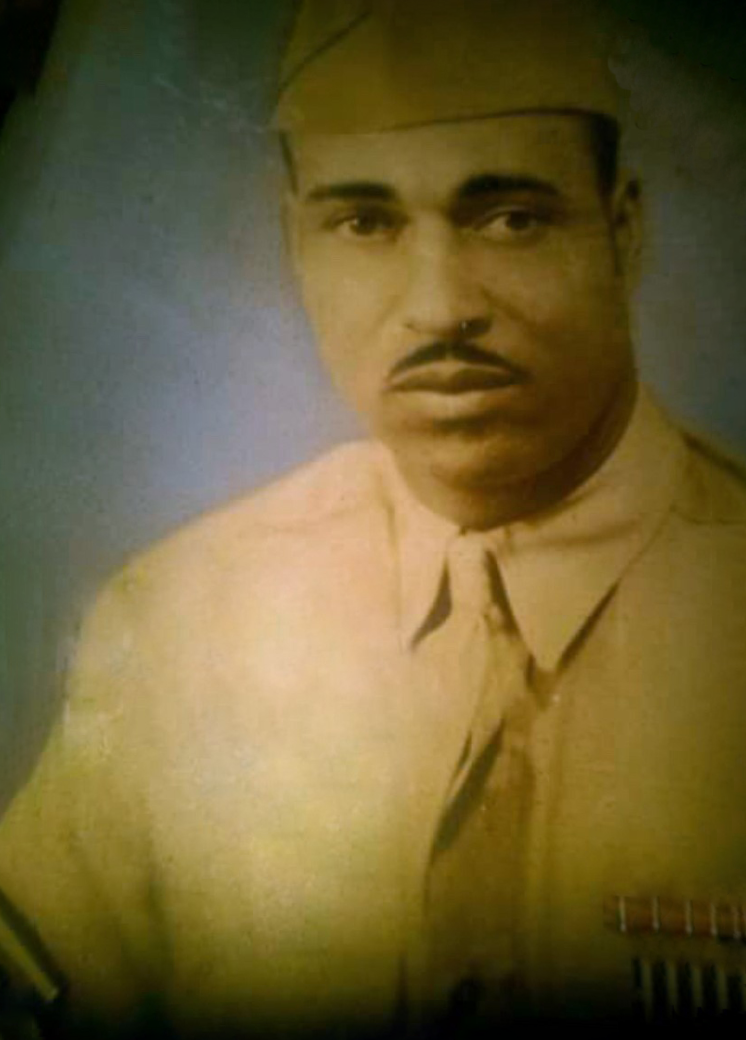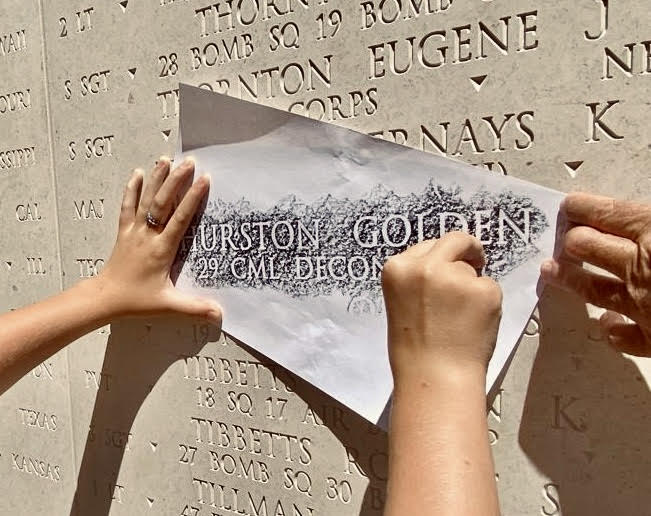Technician Fifth Grade Golden Lock Thurston

- Unit: 29th Chemical Decontamination Company
- Service Number: 33040532
- Date of Birth: September 1, 1907
- Entered the Military: October 16, 1940
- Date of Death: May 21, 1944
- Hometown: Stevensburg and Charlottesville, Virginia
- Place of Death: West Loch, Pearl Harbor, Hawai’i
- Cemetery: Courts of the Missing, National Memorial Cemetery of the Pacific, Honolulu, Hawai’i
Mentored by Mr. Matthew Elms
Singapore American School
2021-2022
Early Life
Childhood
Golden Lock Thurston of Stevensburg, Virginia, was born the second youngest of seven siblings in 1907 or 1909. His father did not live with his family throughout Thurston’s early life, which was defined by his mother, Cornelia. She and Thurston’s older siblings supported the family through various jobs like washing clothes, laboring, and cooking for local families. Cornelia ensured that each of her children attended school and learned to read and write. This school might have been Eckington School, a local segregated grammar school for African American children. She herself went from being illiterate at the time of Thurston’s birth to being literate when he was ten years old.
Adulthood
Thurston married Isabella Harris around the age of 18. Together, they had one child, Robert Thurston. It seems that he lived with her for a very brief time and moved to Charlottesville, Virginia around 1930. There, he had two children, James Henry Foster and Anna Lee Foster with his future wife, Mary Smith. There he also worked in the sports department of the University of Virginia as a janitor under the supervision of Norton Pritchett.
Homefront
When Thurston was growing up just 80 miles away from the capital of the Confederacy in Jim Crow-era Virginia, racial tensions were extremely high. Monuments to Confederate leaders were being built at a rapid pace, segregation and Jim Crow laws dominated education and general society, and many African American communities were plagued by poverty. This poverty only increased during the Great Depression, and New Deal policies intended to alleviate deprivation often excluded African Americans.
World War II created a booming wartime economy. Virginia, like the rest of the country, became home to factories converted to supply the war effort. In Warrenton, Virginia, Vint Hill Farm Station monitored international radio signals from 1942 until 1945 and continued to be used by the National Security Administration (NSA), Central Intelligence Agency (CIA), and the U.S. Army until the 1990s. During World War II, the facility notably intercepted 20 pages of morse code written by Japan’s German ambassador, Baron Oshima, that gave information about German expectations of an allied invasion of France.
Throughout the war, African Americans were encouraged to fight a Double V Campaign, or victory abroad against the injustices of the Axis powers in addition to victory at home against the injustices of racial segregation, violence, and inequality.
Military Experience
Training and Duties
When Thurston was drafted in 1942, he labeled his next of kin as his older sister, Maime, and served in the highly specialized 2nd Chemical Decontamination Company, later designated the 29th Chemical Decontamination Company. He trained in Fort Leonard Wood, a U.S. Army training installation in the Missouri Ozarks. There, he was a Fifth Grade Technician, a very high rank for an African American man with limited education. This rank was likely due either to his past work experience handling chemicals or to his age, as he was in his early 30s when he enlisted in the U.S. Army.
Technician Thurston’s specific duties with the company included putting out grass fires, handling dangerous Chemical Warfare Service weapons, and organizing anti-mosquito spraying efforts to combat the very real risk of dengue fever in Honolulu. The 29th Chemical Decontamination Company “were building infrastructure, fighting fires, protecting combat troops from chemical weapons, loading ammunition and fuel. Wars couldn’t have been won without them,” according to the President of the African American Diversity Cultural Center in Hawaiʻi, Deloris Guttman.
West Loch Disaster
On May 21, 1944, the 29th Chemical Decontamination Company was in the process of unloading 4.2-inch mortar shells onto a row of 29 Landing Ship, Tanks (LSTs) for a pre-departure mortar shell experiment when Pearl Harbor’s West Loch exploded three times in a little-known accident. The explosions threw pieces of wood, body parts, and shrapnel hundreds of feet, sank six LSTs, seriously damaged several others, killed 163 people, and wounded over 350 more. The West Loch Disaster was Hawaiʻi’s second-greatest disaster in terms of casualties after Pearl Harbor’s December 7, 1941 attack.
Technician Thurston and an estimated 58 others from his mostly African American unit represent a significant number of those casualties. The sacrifices of the 29th Chemical Decontamination Company remained unacknowledged throughout evaluation by the Court of Inquiry and eventual memorialization after the events at West Loch were declassified in 1962. The unit was blamed for dropping the mortar shell that started the first explosion on LST-353. “The Court of Inquiry found that a dropped mortar round was a likely cause of the explosions. One problem with that conclusion is that testimony showed that the men [of the 29th] were on break at the time of the explosion so they weren’t handling the shells. Another problem is that…they were unarmed. Finally, dropped 4.2″ mortar shells will not explode…,” explains Associate Professor John Theil (United States Army Retired, Chemical Corps Hall of Fame). It was later discovered that a rogue cigarette butt from another unit was likely the catalyst.
The West Loch Disaster as a whole was kept secret and did not delay the invasion of Saipan. The 29th Chemical Decontamination Company remained stationed at Schofield Barracks and participated in preparing for Operation Forager, the invasion of the Mariana and Palau Islands that occurred in the Pacific Theater between June and November 1944. Punchbowl officials and advocates hope that the remains of the 29th Chemical Decontamination Company’s West Loch victims, now only known as being missing in action and buried in unknown graves, be recovered and identified with the help of the Defense POW/MIA Accounting Agency.



Eulogy
Today, we remember Technician Thurston not only as an undervalued hero but also as one man who made the ultimate sacrifice for his country. He came from an impoverished county in rural Virginia, joined an unrecognized unit, and died in an obscure accident, but he gave his life to the American cause, something we should all be grateful for.

Plaque commemorating the sacrifices of the 201st Chemical Maintenance Company and 29th Chemical Decontamination Company, Fort Leonard Wood, Missouri. Courtesy of Mr. John Theil.

The only public commemoration of Thurston’s war efforts can be found in Hawaiʻi National Memorial Cemetery of the Pacific Cemetery, where his name is memorialized on Court Five of the Honolulu Memorial.
Reflection
One nerve-wracking application process, six months of back and forth with my teacher and the SFF experts, an unbelievable week in Hawaiʻi, and a student zoom reunion later, and I still cannot believe how lucky I am to have been a part of the 2022 SFF Pacific cohort.
The fortnightly modules that examined the broad strokes of the Pacific Theater gave me a fantastic understanding of the war and did an unmatched job of building empathy for every group of affected people. Discovering Mr. Thurston’s story filled with excellence and honor with the help of so many generous experts and databases gave me hope for the future of historians, however paradoxical that might be. The week on site was the kind that appears in the first chapter of one’s memoirs. I will always remember the delightfully overwhelming feeling of meeting so many kindred spirits -guides, students, teachers, and coordinators- at one time. I will happily continue to search for that feeling of belonging, of constant rabbit holes of information just waiting to be uncovered, and of connection between people and places across time.
I now feel ready to dive into another NHD project, to continue to search for stories that are begging to be told in all of my classes, and fully appreciate the importance of history that is all around us. I am fortunate enough to live next to the incredible Smithsonian Museums of Washington D.C., where I have a much greater understanding of all the painstaking but worthwhile work that goes on behind each exhibit, thanks, especially to our visit to the USS Missouri Educational Resource Center. Perhaps most importantly and most unexpectedly, I will have a bit more respect for the American flag; every time I see it flapping in the wind, I will think of the one we raised on the deck of the USS Missouri across from the USS Arizona Memorial, and I will never forget.
This profile could not have been possible without the help of Ms. Deloris Guttman and Mr. John Theil.
Bibliography
Primary Sources
“Ain’t Gonna Sting No More. Waikiki Area Sprayed.” Honolulu Advertiser [Honolulu, Hawaii], August 13, 1943. Newspapers.com (258837840). https://www.newspapers.com/image/258837840/.
“Golden L. Thurston.” American Battle Monuments Commission. Accessed October 24, 2022. https://www.abmc.gov/decedent-search/thurston%3Dgolden.
Golden L. Thurston. Defense POW/MIA Accounting Agency, Unaccounted-for Remains, Group A (Recoverable), 1941-1975. ancestry.com.
Golden L. Thurston. World War II Army Enlistment Records, 1938-1946. Digital Images. ancestry.com.
Golden L. Thurston. World War II Hospital Admission Card Files, 1942-1954. Digital Images. ancestry.com.
Golden Lock Thurston. Virginia, U.S., Select Marriages, 1785-1940. ancestry.com.
Golden Lock Thurston. World War II Draft Cards Young Men, 1940-1947. Digital Images. ancestry.com.
Pearl Harbor LST Explosion, 21 May 1944. Photograph. May 21, 1944. Naval History and Heritage Command (80-G-276907). https://www.history.navy.mil/content/history/nhhc/our-collections/photography/numerical-list-of-images/nara-series/80-g/80-G-270000/80-G-276907.html.
United States War Department. Chemical Decontamination Company Field Manuel (FM) 3-70. Washington: U.S. Government Printing Office, 1944. National Library of Medicine (W2 A2 W2f no.3-70 1944). https://catalog.nlm.nih.gov/permalink/01NLM_INST/1o1phhn/alma991843293406676.
Virginia. Charlottesville City. 1930 U.S. Federal Census. Digital Images. http://ancestry.com.
Virginia. Culpeper County. 1910 U.S. Federal Census. Digital Images. http://ancestry.com.
Virginia. Culpeper County. 1920 U.S. Federal Census. Digital Images. http://ancestry.com.
Secondary Sources
“Beginnings Of Black Education.” Virginia Museum Of History & Culture. Accessed November 1, 2022.
https://virginiahistory.org/learn/historical-book/chapter/beginnings-black-education.
Collins, Katherine. “Soldiers Lost at West Loch Remembered.” Hawaii Army Weekly, June 12, 2015.
https://www.army.mil/article/150442/soldiers_lost_at_west_loch_remembered.
Daysog, Rick. “West Loch Disaster’s Unknown Soldiers.” Hawaii News Now, May 25, 2014. https://www.hawaiinewsnow.com/story/25603505/west-loch-tragedy/.
“Eckington School.” The Historical Marker Database. Accessed October 24, 2022. https://www.hmdb.org/m.asp?m=59522.
Guttman, Deloris. In-person interview with Anna Bronwyn Turney and Matthew Elms. July 29, 2022.
Johnson, William L. The West Loch Story: Hawaii’s Second Greatest Disaster in Terms of Casualties. Seattle: Westloch Publishers, 1986.
Little, Becky. “This Virginia Winery Once Housed One Of WWII’s Most Important Spy Stations.” Smithsonian Magazine, March 14, 2017. https://www.smithsonianmag.com/travel/cold-war-museum-winery-virginia-180962428/.
Prats, J. J. Eckington School Historical Marker. Photograph. September 15, 2012. The Historical Marker Database. https://www.hmdb.org/m.asp?m=59522.
Salecker, Gene Eric. Second Pearl Harbor: The West Loch Disaster, May 21, 1944. Norman: University of Oklahoma Press, 2018.
“Tec5 Golden Lock Thurston.” Find a Grave. Accessed October 24, 2022. www.findagrave.com/memorial/56133644/golden-lock-thurston.
Theil, John. Email interview with Anna Bronwyn Turney and Matthew Elms. March 7, 2022, and June 13-16, 2022.
“Thurston, Golden Lock., T/5.” Together We Served. Updated 2011. Accessed October 24, 2022. https://army.togetherweserved.com/army/servlet/tws.webapp.WebApp?cmd=ShadowBoxProfile&type=AssignmentExt&ID=206.
World War II: American Homefront. Virginia War Memorial Foundation. 2013. https://vimeo.com/367065423.

